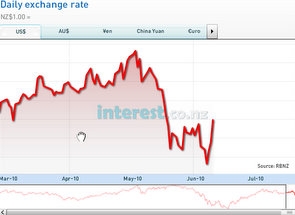
 By Mike Jones*
By Mike Jones*
The NZD has been the strongest performing currency over the past 24 hours.
The twin positives of an RBNZ interest rate hike and gains in global risk appetite combined to propel NZD/USD to 1-week highs above 0.6850 last night. After twelve months of stagnation, at a very low level, the RBNZ yesterday began the process of returning interest rates to a neutral setting.
The OCR was raised to 2.75% from 2.50% in what is expected to be the first move in a series, which will eventually see the rate push up, first, to neutral and then, probably, a little to the tighter side of such.
The NZD’s yield advantage widened as expected. NZ-US 3-year swap spreads increased to 317bps in the wake of the RBNZ’s announcement, from closer to 310bps the day before.
Still, NZD/USD gains were initially limited to the 0.6750 region following RBNZ Governor Bollard’s comments that he is “very cautious on further rate rises”.
However, the NZD/USD extended its gains overnight. Renewed confidence in the strength of the global economy saw equity markets soar and appetite for ‘risk-sensitive’ currencies like the NZD recover.
Australian employment data and Chinese trade data both came out on the stronger side of expectations, and a successful Spanish bond auction tended to support the notion the European sovereign debt crisis is stabilising.
The major global equity indices posted gains of 0.9-2.8% and our risk appetite index (which has a scale of 0-100%) jumped 2% to 37.2%. As a result, “safe-haven” currencies like the USD and JPY were sold in favour of “growth-sensitive” currencies like NZD and AUD.
NZD/JPY climbed from 61.50 to above 62.50 and NZD/USD surged above 0.6850. Sentiment towards ‘commodity-sensitive’ currencies like the NZD was also supported by the 4th consecutive daily increase in the CRB index (a broad index of global commodity prices).
Looking ahead, for the NZD/USD to hold onto its recent gains we’ll have to see more evidence of improvement from tonight’s sizeable batch of global data. A daily close in NZD/USD above 0.6900 would tend to suggest the near-term downtrend has run its course.
Majors
The USD lost some of its “safe-haven” appeal overnight as a burst of generally positive news restored markets’ confidence in the global economic recovery. The major currencies posted gains of 1.0-2.9% against the USD. Policy announcements from the Bank of England and ECB proceeded roughly as expected. Both kept interest rates unchanged. However, markets were somewhat relieved to hear the ECB will continue to provide 3-month emergency loans to banks until September. Most of the data released of the past 24 hours has been on the firmer side of expectations.
Yesterday’s Chinese trade data confirmed exports jumped 48.5%y/y in May, while the Australian unemployment rate recorded a surprise drop to 5.2% (5.4% expected). US data was a bit of a mixed bag but, on balance, tended to match expectations.
Global equity markets surged in response to the more positive economic backdrop. European equities rose 0.9-3.7%, the Dow is up 2.8% and the S&P500 put on 3.0%.
The VIX Index (a proxy for risk aversion) dropped below 31%, from around 34%. Commodity prices increased for the fourth straight session; the CRB index (a broad index of global commodity prices) climbed 0.8%, led by a 1.5% in oil prices (which are now almost 12% above their May lows). Strong gains in equities and commodity prices saw ‘growth-sensitive’ currencies outperform last night.
At the same time, ‘safe-haven’ currencies like the USD and JPY were shunned. Indeed, US Treasury yields soared 7-13bps. AUD/USD jumped from below 0.8300 to nearly 0.8500, USD/CAD slipped over 1% to 1.0300 and GBP/USD rose about 1.5 cents to 1.4700. The EUR even managed to participate in last night’s generalised USD weakness amid hopes the European debt crisis is stabilising.
Not only did last night’s Spanish bond auction prove relatively successful (registering a bid-cover ratio of 2.1), but the German high court rejected attempts to block Germany’s participation in the EU-IMF rescue deal.
The chairman of China’s state pension fund also suggested concerns about European sovereign debt are starting to ease.
While obviously lagging gains in the other majors, EUR/USD managed to climb above 1.2100 for the first time in a week. Looking ahead, we suspect the USD is susceptible to further downside should tonight’s data continue to restore faith in the global economic recovery.
US retail sales and consumer confidence, UK industrial and manufacturing production and a wealth of Chinese economic indicators for May will ensure markets are kept busy. Near-term support on the USD index is eyed towards 86.30, with initial resistance at 87.50.
* Mike Jones is part of the BNZ research team. All its research is available here.
No chart with that title exists.

We welcome your comments below. If you are not already registered, please register to comment.
Remember we welcome robust, respectful and insightful debate. We don't welcome abusive or defamatory comments and will de-register those repeatedly making such comments. Our current comment policy is here.